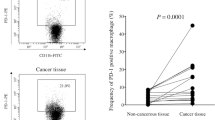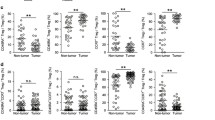Abstract
Existing immune checkpoint inhibitors focus on activating T cells and show limited effectiveness in gastric cancer (GC). SIGLEC10 is identified as a novel tumor-associated macrophage-related immune checkpoint in other cancer types. However, its immunosuppressive role and clinical significance in GC remain unclear. In this study, we find a dominant expression of SIGLEC10 on CD68+ macrophages in GC. SIGLEC10 can suppress the proliferation and function of tumor-infiltrating CD8+ T cells in vitro via the Akt/P38/Erk signaling pathway. Furthermore, in ex vivo and in vivo models, SIGLEC10 blockade promotes CD8+ T cell effector function. Finally, SIGLEC10+ macrophages are positively correlated with the adverse prognosis of GC. Our study highlights that SIGLEC10 directly suppresses T cell function and serves as a promising target for immunotherapy and suggests SIGLEC10+ macrophages as a novel potential predictor of the clinical prognosis of GC.







Similar content being viewed by others
Data availability
The data that support the findings of this study are available from the corresponding author upon reasonable request.
References
Robert C, Robert C (2020) A decade of immune-checkpoint inhibitors in cancer therapy. Nat Commun 11(1):3801
Robert C, Thomas L, Bondarenko I et al (2011) Ipilimumab plus dacarbazine for previously untreated metastatic melanoma. N Engl J Med 364(26):2517–2526
Ansell SM, Lesokhin AM, Borrello I et al (2015) PD-1 blockade with nivolumab in relapsed or refractory Hodgkin’s lymphoma. N Engl J Med 372(4):311–319
Brahmer J, Reckamp KL, Baas P et al (2015) Nivolumab versus docetaxel in advanced squamous-cell non-small-cell lung cancer. N Engl J Med 373(2):123–135
Kim ST, Cristescu R, Bass AJ et al (2018) Comprehensive molecular characterization of clinical responses to PD-1 inhibition in metastatic gastric cancer. Nat Med 24(9):1449–1458
Kang YK, Boku N, Satoh T et al (2017) Nivolumab in patients with advanced gastric or gastro-oesophageal junction cancer refractory to, or intolerant of, at least two previous chemotherapy regimens (ONO-4538-12, ATTRACTION-2): a randomised, double-blind, placebo-controlled, phase 3 trial. Lancet 390(10111):2461–2471
Janjigian YY et al (2021) First-line nivolumab plus chemotherapy versus chemotherapy alone for advanced gastric, gastro-oesophageal junction, and oesophageal adenocarcinoma (CheckMate 649): a randomised, open-label, phase 3 trial. Lancet 398:27–40
Pollard JW (2004) Tumour-educated macrophages promote tumour progression and metastasis. Nat Rev Cancer 4(1):71–78
Doedens AL, Stockmann C, Rubinstein MP et al (2010) Macrophage expression of hypoxia-inducible factor-1 alpha suppresses T-cell function and promotes tumor progression. Cancer Res 70(19):7465–7475
Lin C, He H, Liu H et al (2019) Tumour-associated macrophages-derived CXCL8 determines immune evasion through autonomous PD-L1 expression in gastric cancer. Gut 68(10):1764–1773
Menguy S, Prochazkova-Carlotti M, Beylot-Barry M et al (2018) PD-L1 and PD-L2 are differentially expressed by macrophages or tumor cells in primary cutaneous diffuse large B-cell lymphoma. Leg Type Am J Surg Pathol 42(3):326–334
Wang XB, Giscombe R, Yan Z, Heiden T, Xu D, Lefvert AK (2002) Expression of CTLA-4 by human monocytes. Scand J Immunol 55(1):53–60
Kryczek I, Zou L, Rodriguez P et al (2006) B7–H4 expression identifies a novel suppressive macrophage population in human ovarian carcinoma. J Exp Med 203(4):871–881
Munday J, Kerr S, Ni J et al (2001) Identification, characterization and leucocyte expression of SIGLEC-10, a novel human sialic acid-binding receptor. Biochem J 355(Pt 2):489–497
Yin SS, Gao FH (2020) Molecular Mechanism of Tumor Cell Immune Escape Mediated by CD24/SIGLEC-10. Front Immunol 11:1324
Bandala-Sanchez E, G Bediaga N, Goddard-Borger ED et al (2018) CD52 glycan binds the proinflammatory B box of HMGB1 to engage the SIGLEC-10 receptor and suppress human T cell function. Proc Natl Acad Sci U S A 115(30):7783–7788
Barkal AA, Brewer RE, Markovic M et al (2019) CD24 signalling through macrophage SIGLEC-10 is a target for cancer immunotherapy. Nature 572(7769):392–396
Wang J, Sun J, Liu LN et al (2019) SIGLEC-15 as an immune suppressor and potential target for normalization cancer immunotherapy. Nat Med 25(4):656–666
Jiang KY, Qi LL, Kang FB, Wang L (2022) The intriguing roles of SIGLEC family members in the tumor microenvironment. Biomark Res 10(1):22
Cancer Genome Atlas Research Network (2014) Comprehensive molecular characterization of gastric adenocarcinoma. Nature 513:202–209
Kumar V, Ramnarayanan K, Sundar R et al (2022) Single-cell atlas of lineage states, tumor microenvironment, and subtype-specific expression programs in gastric cancer. Cancer Discov 12(3):670–691
Satija R, Farrell JA, Gennert D, Schier AF, Regev A (2015) Spatial reconstruction of single-cell gene expression data. Nat Biotechnol 33(5):495–502
Stuart T, Butler A, Hoffman P et al (2019) Comprehensive integration of single-cell data. Cell 177(7):1888-1902.e21
Kim EH, Sullivan JA, Plisch EH et al (2012) Signal integration by Akt regulates CD8 T cell effector and memory differentiation. J Immunol 188(9):4305–4314
D’Souza WN, Chang CF, Fischer AM, Li M, Hedrick SM (2008) The Erk2 MAPK regulates CD8 T cell proliferation and survival. J Immunol 181(11):7617–7629
Rincón M, Pedraza-Alva G (2003) JNK and p38 MAP kinases in CD4+ and CD8+ T cells[J]. Immunol Rev 192(1):131–142
Adeegbe DO, Liu Y, Lizotte PH et al (2017) Synergistic immunostimulatory effects and therapeutic benefit of combined histone deacetylase and bromodomain inhibition in non-small cell lung cancer. Cancer Discov 7(8):852–867
Fraschilla I, Pillai S (2017) Viewing SIGLECs through the lens of tumor immunology. Immunol Rev 276(1):178–191
Stoger JL, Goossens P, de Winther MPJ (2010) Macrophage heterogeneity: relevance and functional implications in atherosclerosis. Curr Vasc Pharmacol 8(2):233–248
Petty AJ, Yang Y (2017) Tumor-associated macrophages: implications in cancer immunotherapy. Immunotherapy 9(3):289–302
Kersten K, Hu KH, Combes AJ et al (2022) Spatiotemporal co-dependency between macrophages and exhausted CD8+ T cells in cancer. Cancer Cell 40(6):624-638.e9
Li B, Zhang B, Wang X et al (2020) Expression signature, prognosis value, and immune characteristics of SIGLEC-15 identified by pan-cancer analysis[J]. Oncoimmunology 9(1):1807291
Stasi R (2008) Gemtuzumab ozogamicin: an anti-CD33 immunoconjugate for the treatment of acute myeloid leukaemia. Expert Opin Biol Ther 8(4):527–540
Adeel K, Fergusson NJ, Shorr R, Atkins H, Hay KA (2021) Efficacy and safety of CD22 chimeric antigen receptor (CAR) T cell therapy in patients with B cell malignancies: a protocol for a systematic review and meta-analysis. Syst Rev 10(1):35
Xiao N, Zhu X, Li K et al (2021) Blocking SIGLEC-10hi tumor-associated macrophages improves anti-tumor immunity and enhances immunotherapy for hepatocellular carcinoma. Exp Hematol Oncol 10(1):36
Acknowledgements
The authors would like to thank National Natural Science Fund for Distinguished Young Scholars, National Natural Science Foundation of China, and National Key Research and Development Program of China for their financial support.
Funding
Funding was provided by National Natural Science Foundation of China, (Grant Nos. 32070878, 81970497).
Author information
Authors and Affiliations
Contributions
All authors contributed to the study conception and design. Experiment was designed and performed by YG and SK. Data collection and analysis were performed by FX and YG. Manuscript was written by YG, SK, and JC. Pathological analysis was performed by YS and XL. Bioinformatics analysis was performed by FX and DX. The manuscript was revised by JC. The study was designed and supervised by GZ, HL, and WZ. All authors read and approved the final manuscript.
Corresponding authors
Ethics declarations
Conflict of interest
The authors declare no potential conflicts of interest.
Ethical approval
All experiments were approved by the Ethical Committee of the Shanghai Jiao Tong University School of Medicine, Renji Hospital (no. 2017–114-CR-02). All procedures followed the ethical guidelines of the Declaration of Helsinki and the guidelines of the China Ethics Review Committee before starting the experiment. Informed consent or a substitute for it was obtained from all patients included in this study.
Additional information
Publisher's Note
Springer Nature remains neutral with regard to jurisdictional claims in published maps and institutional affiliations.
Supplementary Information
Below is the link to the electronic supplementary material.
A
CD163 and CD206 expression in SIGLEC10+ macrophage and SIGLEC10- macrophage were measured by FACS. B TIGIT, TNFRSF1B, CD44 and ICOS expression of CD8+ T cell in tumor tissue and normal tissue from gastric cancer subjects were measured by FACS. C TNF, SPP1 and NECTIN2 expression of SIGLEC10+ macrophage in tumor tissue and normal tissue from gastric cancer subjects were measured by FACS (TIF 2005 KB)
A
SIGLEC10 expression in SIGLEC10/Ctrl-overexpression (SIGLEC10/Ctrl-OE) macrophage were measured by FACS. B CD8+ T cells were isolated by magnetic beads from GC patients’ samples. Celltrace Violet (CTV) labeled CD8+ T cell macrophage were co-culture with SIGLEC10/Ctrl-OE macrophage for 72 hrs at ratios (1:2), then the proliferate ability of CD8+ T cells was measured by FACS. C CD8+ T cells were isolated by magnetic beads from GC patients’ samples. CD8+ T cells were co-culture with SIGLEC10/Ctrl-OE macrophage for 72 hrs at ratio (macrophages:CD8+ T cells, 1:2), then the TNF-α and IFN-γ expression of CD8+ T cells was measured by FACS (TIF 1582 KB)
A
NSG mice were entailed injection with tumor-matched PBMC (5×106). Then patients-derived tumor was implanted 2 days after PBMC engraftment. Mice received anti-SIGLEC10 mAb or IgG isotype control treatment 6 days after tumor engraftment. B Tumor volumes were measured every 2 days. The plot showed the tumor growth curve. C Tumor volumes on day 24. D The SIGLEC10 expression of tumor-infiltrating macrophage in different groups was measured by FACS. E&F The TNF-α and IFN-γ expression of tumor-infiltrating CD8+ T cells in different groups were measured by FACS (TIF 1919 KB)
Rights and permissions
Springer Nature or its licensor (e.g. a society or other partner) holds exclusive rights to this article under a publishing agreement with the author(s) or other rightsholder(s); author self-archiving of the accepted manuscript version of this article is solely governed by the terms of such publishing agreement and applicable law.
About this article
Cite this article
Guo, Y., Ke, S., Xie, F. et al. SIGLEC10+ macrophages drive gastric cancer progression by suppressing CD8+ T cell function. Cancer Immunol Immunother 72, 3229–3242 (2023). https://doi.org/10.1007/s00262-023-03488-2
Received:
Accepted:
Published:
Issue Date:
DOI: https://doi.org/10.1007/s00262-023-03488-2




